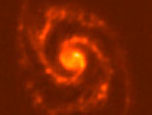The European Space Agency's Herschel Space Observatory opened its 'eyes' on 14 June and the Photoconductor Array Camera and Spectrometer inside it obtained images of M51, the whirlpool galaxy.
Scientists obtained images in three colours, which clearly demonstrated the capabilities of the large infrared space telescope - the only space observatory to cover a spectral range from the far infrared to sub-millimetre.
The image below shows the famous whirlpool galaxy, first observed in 1773 by Charles Messier, who provided the designation Messier 51 (M51).
This spiral galaxy lies relatively nearby, about 35m light years away in the constellation Canes Venatici. M51 was the first galaxy discovered to harbour a spiral structure.
The image is a composite of three observations taken at 70, 100 and 160 microns by Herschel’s Photoconductor Array Camera and Spectrometer (PACS) on 14 and 15 June, immediately after the satellite’s cryocover was opened.
Herschel, launched only a month ago, is still being commissioned. But engineers and scientists were challenged to try to plan and execute a test observation as part of a ‘sneak preview’ immediately after the cryocover was opened. The objective was to produce a very early image that gives a glimpse of things to come.

To the left is the best image of M51 taken by NASA’s Spitzer Space Telescope, with the Multiband Imaging Photometer for Spitzer (MIPS), juxtaposed with the Herschel observation.
The obvious advantage of the larger size of the telescope is clearly reflected in the much higher resolution of the image: Herschel reveals structures that cannot be discerned in the Spitzer image.




Glasgow trial explores AR cues for autonomous road safety
They've ploughed into a few vulnerable road users in the past. Making that less likely will make it spectacularly easy to stop the traffic for...